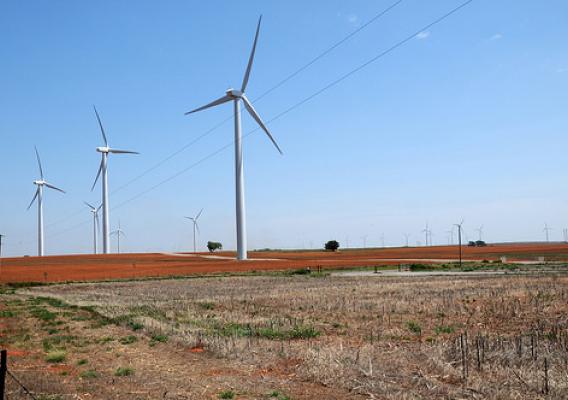 Title IX: Energy of the Farm Bill addresses renewable energy programs used to incentivize research, development, and adoption of renewable energy projects and energy efficiency. However, “the primary focus of USDA renewable energy programs has been to promote U.S. biofuels production and use,” in particular corn-starch ethanol, which dominates the U.S. biofuels industry.[1]
Title IX: Energy of the Farm Bill addresses renewable energy programs used to incentivize research, development, and adoption of renewable energy projects and energy efficiency. However, “the primary focus of USDA renewable energy programs has been to promote U.S. biofuels production and use,” in particular corn-starch ethanol, which dominates the U.S. biofuels industry.[1]
The cornerstone program of the Energy Title is the Rural Energy for America Program (REAP). The program provides grants and loan funding to farmers and small businesses to purchase or install renewable energy systems or make energy efficiency improvements.[2] Over thirty-thousand grants have been handed out through this program since 2012, ranging from $3000 to $72,500,000. While this program has allowed for the creation of many rural solar, wind, hydropower, geothermal projects, and energy efficiency projects, it has also funded the installation of many ethanol blender pumps, anaerobic digesters, and other biodiesel and biofuel installations. For a complete breakdown of the projects funded through this program, check here, in the investment map data. In the 2014 Farm Bill, a new provision precludes REAP from funding blender pumps or any mechanisms for dispensing energy at the retail level.[3] It also prevents funds from being allocated to feasibility studies for future projects. The 2014 Farm Bill added a three-tiered application process with separate applications for grants and loan guarantees based on the project cost, with evaluation and oversight processes becoming more comprehensive with more expensive programs. REAP is the highest funded energy program under the bill, although the 2014 Farm Bill reduced funds for this program to $50 million annually in mandatory funding and $20 million in discretionary funding from the $361 million in received in 2010.[3]
The Rural Energy Savings Program provides loan opportunities to rural families, small businesses, and small farmers to implement energy saving and energy efficiency measures and technologies, the goal being to save costs by decreasing the energy demand in rural areas.
Another important program under Title XI: Energy is the Biomass Crop Assistance Program (BCAP), which “provides incentives to help farmers grow advanced bioenergy feedstocks (crops that are well-suited to be turned into energy) and connect with relevant refineries in their area. BCAP is not intended to fund crops that are primarily grown for food or animal feed.”[4] Funds can be provided through cost-sharing or matching payments. The 2014 Farm Bill clarifies that subsidized commodity crops are not eligible for BCAP funding, limiting eligible crops to grasses, trees, algae or other cellulosic plants. It requires the inclusion of a conservation or forest stewardship plan in the contract for harvesting any eligible materials.[5]
The Biobased Markets Program (or BioPreferred) is a federal biobased procurements preference program that requires federal agencies to purchase biobased products when the cumulative price of procurement is more than $10,000.[3] It also includes a voluntary labeling program for biobased products, and the 2014 Farm Bill added auditing and compliance activities to ensure proper use of this labeling. In addition, the 2014 Farm Bill requires reporting of biobased products by procuring agencies and a study of the economic impacts of the program.[6] That study can be found here. Notably, it states that the biobased product industry contributed $369 billion to the US economy in 2013. Funding for the BioPreferred Program increased to $3 million per year in mandatory funding and $2 million per year in discretionary funding is authorized, up from $2 million in mandatory funding in the prior bill.[6]
Although the 2014 Farm Bill made some progress towards supporting non-food sources and other renewable forms of energy, programs need to be carefully evaluated to ensure that they are not benefitting the corn ethanol industry. For example, more than half of the funding for projects under the Bioenergy Production for Advanced Biofuels (BPAB) program, designed to provide direct payments to biofuel producers, was awarded to soy biodeisel and corn ethanol facilities between 2009 and March 2014.[7] The 2014 Farm Bill is expected to carry on those same trends.
For a comprehensive summary of energy programs authorized under this title, check here.
[1] Chite, Ralph. The 2014 Farm Bill (P.L. 113-79): Summary and Side-by-Side, Congressional Research Service. http://nationalaglawcenter.org/wp-content/uploads/2014/02/R43076.pdf
[2] USDA. “Rural Energy for America Program,” http://www.rd.usda.gov/programs-services/rural-energy-america-program-renewable-energy-systems-energy-efficiency
[3] Schnepf, Randy. Energy Provisions in the 2014 Farm Bill (P.L. 113-79), Congressional Research Service. http://nationalaglawcenter.org/wp-content/uploads/assets/crs/R43416.pdf
[4] National Sustainable Agriculture Coalition. “Biomass Crop Assistance Program” http://sustainableagriculture.net/publications/grassrootsguide/renewable-energy/biomass-crop-assistance-program/
[5] Environmental Law & Policy Center. “A Summary of Key Changes in the Farm Bill’s Energy Title.” http://farmenergy.org/news/summary-key-changes-farm-bills-energy-title
[6] USDA. “Agricultural Act of 2014: Highlights and Implications; Energy,” http://www.ers.usda.gov/agricultural-act-of-2014-highlights-and-implications/energy.aspx
[7] Taxpayers for Common Sense. “Bioenergy Program for Advanced Biofuels Fact Sheet”, http://www.taxpayer.net/library/article/bioenergy-program-for-advanced-biofuels-fact-sheet
